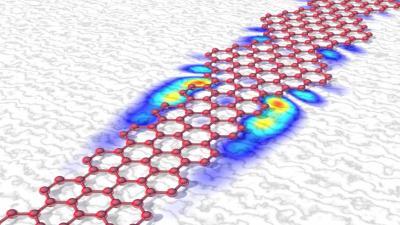Researchers at EMPA (Swiss Federal Laboratories for Materials Science and Technology), along with colleagues from the Max Planck Institute for Polymer Research in Mainz and other partners, have succeeded in precisely controlling the properties of graphene nano-ribbons (GNRs) by specifically varying their shape. This can be used to generate specific local quantum states, and could in the future be used for precise nano-transistors or possibly even quantum computing.

The team has shown that if the width of a narrow graphene nano-ribbon changes, in this case from seven to nine atoms, a special zone is created at the transition: because the electronic properties of the two areas differ in a special, topological way, a "protected" and thus very robust new quantum state is created in the transition zone. This local electronic quantum state can be used as a basic component to produce tailor-made semiconductors, metals or insulators - and perhaps even as a component in quantum computers.
"The importance of this development is also underlined by the fact that a research group at the University of California, Berkeley, came to similar results independently of us," said Gröning.
Based on these novel quantum chains, precise nano-transistors could be manufactured in the future, which can be seen as a fundamental step on the way to nano-electronics. Whether the switching distance between the "1" state and the "0" state of the nano-transistor is actually large enough depends on the bandgap of the semiconductor - and with the new method this can be set almost at will.
In reality, however, this is not quite as simple: for the chain to have the desired electronic properties, each of the several hundred or even thousands of atoms must be in the right place. "This is based on complex, interdisciplinary research," says Gröning. "Researchers from different disciplines in Dübendorf, Mainz, Dresden, and Troy (USA) worked together - from theoretical understanding and specific knowledge of how precursor molecules have to be built and how structures on surfaces can be selectively grown to structural and electronic analysis using a scanning tunneling microscope."
Ultrasmall transistors were named as the obvious application possibility. While technically challenging, electronics based on nano-transistors actually work fundamentally the same as today's microelectronics. The semiconducting nano-ribbons produced by the Empa researchers would allow transistors with a channel cross-section 1,000 times smaller than typically manufactured today. However, further possibilities can also be imagined, for example in the field of spintronics or quantum informatics.
This is because the electronic quantum states at junctions of graphene nano-ribbons of different widths can also carry a magnetic moment. This could make it possible to process information not by charge as was previously done, but by the spin - in the figurative sense the "direction of rotation" of the state. And the development could even go one step further. "We have observed that topological end states occur at the ends of certain quantum chains. This offers the possibility of using them as elements of so-called qubits - the complex, interlocked states in a quantum computer," explains Oliver Gröning.
There is, of course, a lot of research needed before these applications can be achieved. The fact that these materials are stable under environmental conditions plays an important role in the development of future applications. "The further-reaching potential of the chains to create local quantum states and link them together in a targeted manner is also fascinating," Gröning said. "Whether this potential can actually be exploited for future quantum computers remains to be seen, however. It is not enough to create localized topological states in the nano-ribbons - these would also have to be coupled with other materials such as superconductors in such a way that the conditions for qubits are actually met."

